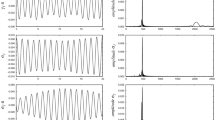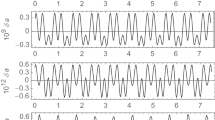Abstract
Two different procedures for analytically modeling the effects of the Moon's direct gravitational force on artificial Earth satellites are discussed from theoretical and numerical viewpoints. One is developed using classical series expansions of inclination and eccentricity for both the satellite and the Moon, and the other employs a method of averaging. Both solutions are seen to have advantages, but it is shown that while the former can be more accurate in special situations, the latter is quicker and more practical for the general orbit determination problem where observed data is used to correct the orbit in near real time.
Similar content being viewed by others
References
Eckert, W. J., Jones, R. and Clark, H. K.: 1954, Improved Lunar Ephemeris 1952–1959, US Government Printing Office, Washington D.C.
Giacaglia, G. E. O.: 1974, ‘Lunar perturbations of artificial satellites of the Earth’, Celest. Mech. 9, 239–267.
Hujsak, R. S.: 1979, A Restricted Four Body Solution for Resonating Satellites Without Drag, Special Astrodynamic Report 1, Aerospace Defense Command.
Jeffreys, B. S.: 1965, ‘Transformation of tesseral harmonics under rotation’, Geophys. J., 10, 141–145.
Kaula, W. M.: 1962, ‘Development of the lunar and solar disturbing functions for a close satellite’, Astron. J., 67, 300–303.
Kaula, W. M.: 1966, Theory of Satellite Geodesy, Blaisdell Publishing Co., Waltham, Ma.
Kozai, Y.: 1966, Lunar Perturbations with Short Periods, Special Report 235, SAO, Cambridge Ma.
Koazi, Y.: 1973, A New Method to Compute Lunisolar Perturbations in Satellite Motions, Special Report 349, SAO, Cambridge Ma.
Lane, M. T.: 1989, On Analytic Modeling of Lunar Perturbations of Artificial Satellites of the Earth, Technical Report 841, MIT Lincoln Laboratory.
Musen, P., Bailie, A., and Upton, E.:1961, Development of the Lunar and Solar Perturbations in the Motion of an Artificial Satellite, Technical Note D-494, NASA.
Sridharan, R. and Seniw, W. P.: 1979, An Intermediate Averaged Theory for High Altitude Orbits, Technical Note 1979-25, MIT Lincoln Laboratory.
Szeto, A. and Lambeck, K.: 1982, ‘On eccentricity functions for eccentric orbits’, Celest. Mech., 27, 325–337.
Author information
Authors and Affiliations
Additional information
This work was sponsored with the support of the Department of the Air Force under contract F19628-85-C-0002. The views expressed are those of the author and do not reflect the official policy or position of the US Government.
Rights and permissions
About this article
Cite this article
Lane, M.T. On analytic modeling of lunar perturbations of artificial satellites of the earth. Celestial Mech Dyn Astr 46, 287–305 (1989). https://doi.org/10.1007/BF00051484
Issue Date:
DOI: https://doi.org/10.1007/BF00051484




